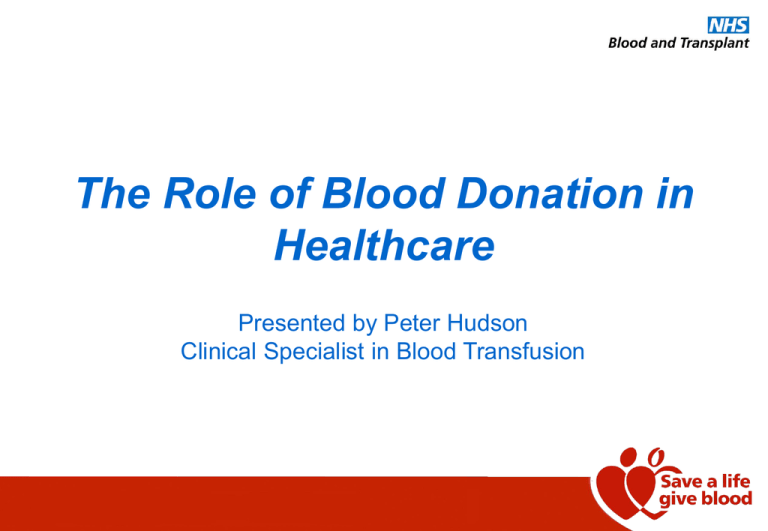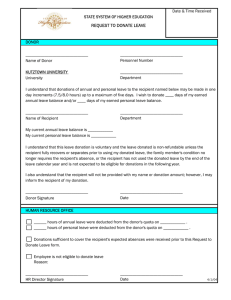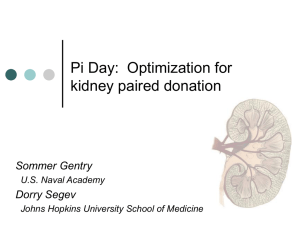Presentation 1
advertisement

The Role of Blood Donation in Healthcare Presented by Peter Hudson Clinical Specialist in Blood Transfusion WHERE DO WE GET OUR BLOOD SUPPLIES FROM? •UK sourced from voluntary unpaid donors •Collected and processed by the National Blood Service WHY GIVE BLOOD? • Over 35,000 donations weekly - 1.4 million donors - Only 4% of people give blood • 10-15% donor loss per year - Donors don’t give every time - Constantly “topping-up” WHO ARE THE NATIONAL BLOOD SERVICE? Part of the National Health Service Provide blood and blood products to hospitals A BRIEF HISTORY OF BLOOD DONATION • 1666: First successful blood transfusion • 1900: Four Human blood types discovered • 1946: National Blood Service Launched SO WHAT EXACTLY IS BLOOD? • Transfers oxygen from the lungs • Communication System within body • Average person has 5 litres of blood COMPONENTS AND THEIR ROLES • Red Cells - Distribute oxygen and nutrients - Contain haemoglobin • White Cells - Fight infection - Several different types COMPONENTS AND THEIR ROLES • Platelets - Form a “plug” to stop bleeding - 5 day shelf-life • Plasma - Carries other blood cells - Carries Albumin and Factor Viii BLOOD TYPES • A, B, AB and O • Antigens - A and B antigens - Rh Antigen BLOOD TYPES BLOOD AROUND THE WORLD • Prevalence varies across the world - B more common in South Asian people than Westerners - Anthropology • Some blood conditions are more common in different communities - Sickle Cell Anaemia and Thalassemia - Events of the past, e.g. plague WHO NEEDS BLOOD? General surgery 10% Gastro intestinal bleeding 11% Haematology 15% • How many units get used? - Open heart surgery = 2-8 red cell units, 6 platelet units - Car accident = 4-40 red cell units Anaemia 23% Orthopaedics 14% RECIPIENT STORIES BROOKE CORNWELL • 2 years old – has received 27 units of blood • Has Diamond Blackfan Anaemia • Needs blood every month to live RECIPIENT STORIES LUKE CRAIG • Involved in a horrific car crash • Internal bleeding and tear in his heart • Emergency operation – 24 units of blood RECIPIENT STORIES MIKE AUSTIN • Severe motorbike accident • Leg destroyed – artery damaged • Received 33 units of blood RECIPIENT STORIES AWELE NWOSU-AKEH • 17 year old with Sickle Cell Anaemia • Receives blood every 4 weeks • Blood allows her to have a normal life RECIPIENT STORIES KEIRA • Kostmann’s syndrome • Bowel removed • 9 units of red cells and 7 of platelets RECIPIENT STORIES NISA HEYS • Has Thalassaemia Major • Has transfusions every 3 weeks • Received over 1300 units of blood so far CAN YOU DONATE? • You must be aged between 17-65 to donate for the first time • Most common criteria we check are:- Tattoos - Piercings - Travel - Medication • You will always be asked to fill out a Donor Health Check questionnaire CAN YOU DONATE? (MYTHS) “I could die as a result of donation” “I might catch something” “You don’t want my blood” “You experiment on our blood” “It hurts”! “I ALWAYS faint”! “I smoke and drink alcohol” THE DONATION PROCESS Making the call Fill out the questionnaire Arrive at session The donation Aftercare DONOR ETHNICITY White Mixed South Asian African & Caribbean Chinese Any Other Group “25% of the South Asian ethnic population are blood group B and only 9% of Western Europeans share this group” DONOR ETHNICITY (cont) • We need to build the British Bone Marrow Registry British Bone Marrow Register • Some tissue types are specific to certain ethnic groups of the population • The notion of blood donation does not enter personal and social spheres WHAT HAPPENS TO THE BLOOD? • Kept cool then collected • Typed and tested • Components Separated • Banked and ready to go! WHAT IS THE BLOOD TESTED FOR? VIRUSES HIV 1 and 2 Hepatitis B Virus (HBV) Hepatitis C Virus (HBC) HTLV (Human T- cell Leukaemia Virus) Cytomegalovirus (CMV) THEY DON’T JUST COLLECT BLOOD • Bone Marrow • Organs • Cord Blood • Tissue THANK YOU FOR LISTENING Any Questions?











